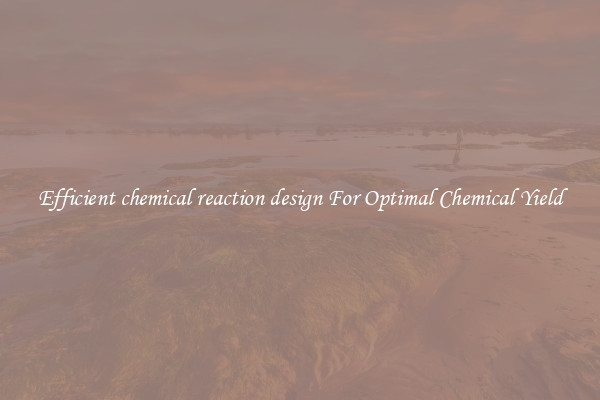Efficient chemical reaction design For Optimal Chemical Yield
Efficient chemical reaction design is crucial in achieving optimal chemical yield in various industries, including pharmaceuticals, agriculture, and materials science. It involves careful consideration of reaction conditions, catalysts, and reactant ratios to maximize the desired product yield while minimizing energy consumption and waste production.

One important aspect of efficient chemical reaction design is choosing the appropriate reaction conditions. Factors such as temperature, pressure, and reaction time can greatly impact the yield of the desired product. By optimizing these parameters, chemists can manipulate the reaction to favor the formation of the desired products. For example, increasing the reaction temperature and pressure might enhance the reaction kinetics and promote the formation of desired products. On the other hand, lower temperatures or the addition of inhibitors might be used to selectively control side reactions or prevent the formation of unwanted byproducts.
Another aspect of efficient chemical reaction design is the choice of catalysts. Catalysts are substances that facilitate the reaction and increase reaction rate without being consumed. They enable reactions to occur under milder conditions, reducing energy consumption and improving product yield. Selecting the most suitable catalysts for a specific reaction can significantly enhance yield and reduce reaction times. Catalysts can be organic or inorganic, homogeneous or heterogeneous, and their choice depends on the reaction type, reactants, and desired products.
Optimizing reactant ratios is another critical factor in efficient chemical reaction design. Stoichiometric ratios and reactant concentrations can heavily influence the reaction equilibrium and product yield. By carefully adjusting these ratios, chemists can drive the reaction towards the desired products while limiting the production of unwanted byproducts. In some cases, reactants may need to be added in multiple steps or in specific sequences to achieve the highest possible yield.
Efficient chemical reaction design also considers the principles of green chemistry, which focus on minimizing waste generation and reducing the environmental impact of chemical processes. This involves utilizing renewable feedstocks, using non-toxic or less hazardous reagents and solvents, and maximizing atom economy – the proportion of reactant atoms that end up in the desired product.
Overall, efficient chemical reaction design is essential to maximize chemical yield while minimizing energy consumption and waste generation. By carefully considering reaction conditions, catalysts, and reactant ratios, chemists can optimize reactions for various industries, contributing to more sustainable and cost-effective manufacturing processes.

View details

View details

View details

View details








